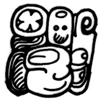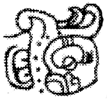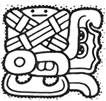



MHD.1M7.1&2 MHD (Van Stone) MHD (Gomez) MHD (Graham)
Stela F B4 JOY Bone Ap3 YAX Lintel 25 G2
TAAJ <<<K’IN:ni>.li>:<ka:me>>.TAAJ TAAJ.<K’UH:NAL> <WIIN:TE’:NAAH>.<wi?/TAAJ?>
· This is quite a rare logogram – a search in MHD on “blcodes contains 1M7” returns only 4 hits, 3 of which are given as examples above (plus the Catalog entry itself makes 4). Even though it’s not a common logogram, the iconographic origin seems clear enough – an obsidian blade with a “darkness” property marker (as obsidian is a jet-black, shiny stone). Does the “hook” at the end represent a handle or a curved point to pierce things with?
· I haven’t been able to find a Bonn equivalent.
· I’m a bit unsure of the transliteration of YAX Lintel 25 G2: TAAJ?-wi-WIIN-TE’-NAAH, as given by MHD:
o The glyph on the far right is apparently thought to be TAAJ = “obsidian”.
o This makes sense, as there is a jagged edge of the blade clearly visible.
o But then, there shouldn’t be a wi transliterated as well. Or vice versa: if there is a syllabogram wi initial phonetic complement present, then there is no logogram TAAJ present. Furthermore, I’m not familiar with TAAJ = “obsidian” being associated with this toponym.
![]()
JM.p224.#5
CPN Stela 11 A3
ta:ji
· Beliaev&Houston-ASSIMW.p3: obsidian, taaj, cuts flesh in acts of sacrifice.
· Do not confuse this with the phonetically similar taj = “torch”.
· EB.p161.pdfp166.#3: taj (2) n. “obsidian”:
o EB never indicates long vowels, but the reference to CPN Stela 11 A3 gives taaj according to the Wichmann-Lacadena rules.
o EB also has a reference to K4655, but this K-number doesn’t seem to be associated with a Maya vase.